One
THE PARALLELOGRAM
AND BEYOND
BUSINESS AND COMMERCE

Drake’s Store, shown in a post–Civil War image, was founded in the late 1830s and served as the midpoint when Minden’s original one-mile-square town limits were laid out in 1854. It was also used as a headquarters by the Union forces that occupied Minden at the conclusion of the Civil War in 1865. (Courtesy of Clair Drake Moore.)

This is a later incarnation of the Drake family’s business on the same site as the original store. The Drake Building (the white structure on the right) was erected in the 1890s and is still in use today. Over the years, many different firms operated in the street-level storefronts while the upstairs provided office space for attorneys, physicians, and other businesses. The Drake Building still has functioning commercial offices upstairs, which are rather unique for downtown Minden. When this image was taken around 1940, the largest storefront was occupied by the A&P grocery store. A&P would later relocate to two other sites in Minden before closing in the 1970s. Another major national retailer, Sears, Roebuck and Co., would open its Minden catalog store in that space in the Drake Building in the 1960s. This image also gives a good view of Minden’s brick Main Street. The bricks were laid in 1917–1918 and remain today. (Author’s collection.)
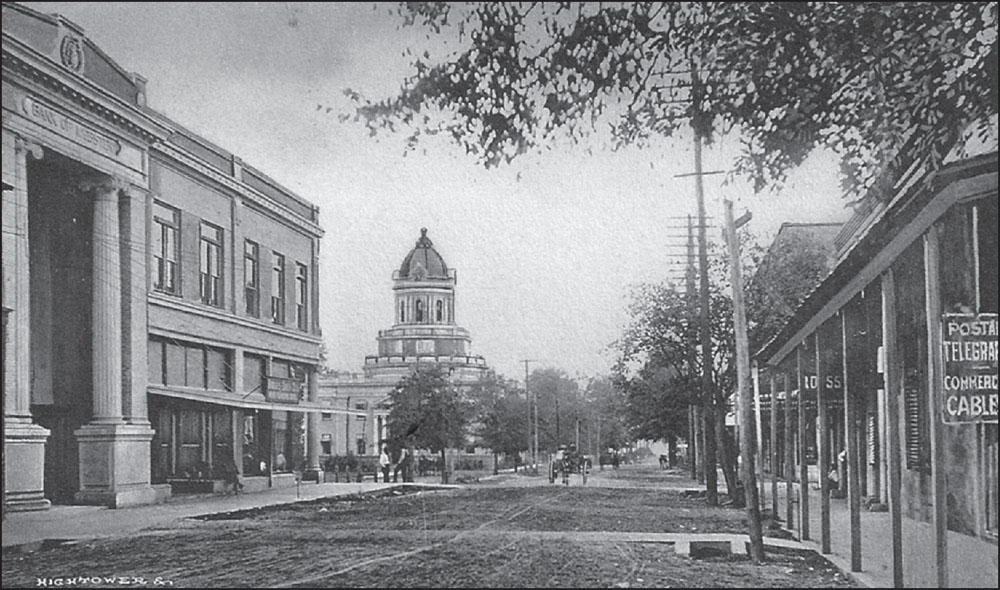
Minden’s c. 1908 Main Street is pictured in a view looking toward the 1905 Webster Parish Courthouse on the left. The Bank of Webster Building in the left foreground had been erected about 1903 on part of the property that had been home to the first business constructed in Minden in 1835, Charles Veeder’s Rock Inn. (Author’s collection.)

The view in this postcard from the first decade of the 20th century looks west (despite the card’s caption) from the modern intersection of Fogle and Main Streets in Minden. The building in the right foreground is Goodwill’s Store, built by pioneer settler Alfred Goodwill, great-grandfather of former Louisiana governor Mike Foster. (Author’s collection.)

From the same series, this postcard view looks east (not north) from the intersection of Main and Pine Streets in Minden. The 1905 Webster Parish Courthouse is prominent in the left side of the picture as is the “hitching lot” in the left foreground. That space has been used for parking—from horse-drawn buggies to cars—since the founding of Minden until today. (Author’s collection.)

This aerial shot of the western edge of Minden along US Highway 80 was taken on December 13, 1941. The property in the right foreground would later be the site of the Joy Drive-In, which entertained Minden from the late 1940s until the 1970s and even hosted a performance by Elvis Presley in 1955. (Courtesy of the Webster Parish Library.)

Another image from the December 1941 series shows downtown Minden as seen from the west. Clearly visible are the shops of the Louisiana & Arkansas (L&A) Railway along the eastern side of the railroad tracks. Other prominent landmarks include the 1905 Webster Parish Courthouse in the middle block between Main Street (more commonly known as Front Street) and Broadway (Back Street). These parallel streets created two business districts—one for blacks and the other for whites. There were a few stores that catered to both races. In the right center of the picture is the Ferguson Memorial Tabernacle of the First Baptist Church, looking rather like an aircraft hangar at first glance. On the cusp of World War II, Minden was also on the edge of a transformation as the massive Louisiana Ordnance Plant, located west of Minden, was nearing completion. (Courtesy of the Webster Parish Library.)

This third image from December 1941 gives a closer look at downtown Minden from the air. Again the Webster Parish Courthouse is prominent, and just to its right is the Minden Post Office, built in 1916. While many of the buildings in this picture remain today, the area around and south of the courthouse is completely changed. Nearly everything in that area was torn down and replaced by the Minden Civic Center in 1970. Toward the right edge of the image is the Ferguson Tabernacle of First Baptist Church. Across the boulevard from the Baptist church to the north is the First Methodist Church of Minden. At the extreme top of the picture is the 1910 Minden public school building, which, by 1941, was serving as the grammar school, with the newer 1924 high school building located to its west. (Author’s collection.)

These two photographs, taken in 1969, show the area around the 1905 Webster Parish Courthouse shortly before its demolition. The structure was then serving as the Minden City Hall since a new courthouse had replaced it in 1953. The newer courthouse is the first building to the west (left) of the 1905 building, across two parking lots. Also by this point, the US post office had been torn down and replaced by a bank. The newer 1960 post office is seen two blocks north of the 1905 courthouse in the image above. The image below gives a good view of the block of businesses directly south of the 1905 courthouse. (Both, author’s collection.)

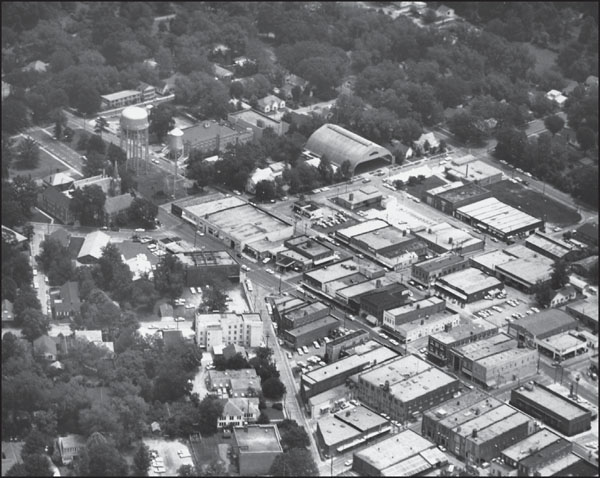
This 1969 image shows the Ferguson Tabernacle, which, in 1977, was torn down in a church expansion project. The photograph gives a better perspective of the location of the First Baptist and First Methodist Churches, for many years the two largest church congregations in Minden, across the boulevard from each other. (Author’s collection.)

Andress Motors Company, the local Ford dealer, is shown on the day of its new car showing in 1956. This building on Main Street housed the local Ford dealer from the early 1920s until 1970. The Andress family operated the business for more than four decades. The building itself remained until the 1990s; today, the property is home to a medical office. (Courtesy of Thad Andress.)

This is an inside view of Andress Motors’ new car show, held in October 1956. The changed designs of the new cars were such a secret in those years that, as shown by the crowd, the chance to see the new vehicles brought out lots of local residents. (Courtesy of Thad Andress.)

Minden had its first movie theater in 1915 and, over the years, had as many as four operating at the same time. Probably the best remembered is the Rex, located in the remodeled building constructed by the First Baptist Church in 1902. In this image, the Rex is decorated for the local premiere of Gone with the Wind in 1940. (Author’s collection.)

In 1927, a group of doctors formed a corporation and established the Minden Sanitarium, bringing a hospital to the community for the first time. Although local ownership no longer possesses the enterprise, this original building is still actually at the core of today’s Minden Medical Center. (Author’s collection.)

The original staff members of the Minden Sanitarium are shown in front of the hospital at the time of its opening. The hospital was somewhat unique for the area of Northwest Louisiana in that, although segregated, it did take black patients, who were housed in the basement of the building. (Author’s collection.)

A telegraph boy is shown in front of the local Western Union office in about 1920. In the background is the First Baptist Church’s 1902 building that was later converted to the Rex Theater. (Author’s collection.)

In 1880, Alfred Goodwill, who had come to Minden from his home in England as a teenage orphan, built a store in downtown Minden that was one of the largest in the state of Louisiana. This image, taken in the mid-1890s, shows Goodwill, seated in the buggy, in front of that store. (Courtesy of the Webster Parish Library.)

The employees of Minden Mercantile, owned by the Turner brothers, are shown in the store, located in downtown Minden in the 1930s. The Turner family owned and operated several businesses, which were largely connected to the timber industry in the Minden area. (Courtesy of George Turner.)

Service Grocery was located in downtown Minden in the Gladney Building. This was one of nearly 40 grocery stores operating in Minden in 1930. A Piggly Wiggly had first been located in this building, but self-service groceries were slow to catch on in Minden, and local full-service firms dominated for years. (Author’s collection.)

This 1949 photograph is of the 600 block of Main Street in Minden. The marquee at the Tower Theater indicates the film being shown is Letter to Three Wives, which is key to dating the image. The large building with a GE Appliances sign at the center left is the Miller Building, which houses many local offices on its upper floor. (Author’s collection.)

The Tower Theater had first been opened under the name Scout Theater. The owner of that theater was Rollin Williams, who also owned the City Drugstore next door to the theater. This image comes from the Scout years at the theater. After the theater closed, the building housed a skating rink, and today, there is a jewelry store. (Courtesy of LSU-Shreveport Archives and Special Collections, Noel Memorial Library.)

The Imperial Hotel was the first “modern” hotel built in Minden after World War I. It became the meeting place for most civic clubs in town and any outside events, like the two education conferences held in Minden between 1920 and 1950. (Author’s collection.)

Pictured in the 1940s, Star Drug was located in the Miller Building. The soda fountain, which was such an important part of drugstores in those days, is at the front left of the image. (Courtesy of the Dorcheat Historical Association Museum.)

Webb Hardware is pictured here. Founded by Samuel G. Webb, the store was owned and run by Will Life for most of its 80 years of operation. (Courtesy of Lillian Life Willis.)

This image shows a Shreveport laundry wagon making pickups and deliveries to Minden in the early years of the 20th century. The contrast of the new with the old in this picture shows a time of transition being experienced in Minden. (Courtesy of the Major De Pingre.)

The Bank of Minden was founded in 1890 and moved into this unique tile-front building in about 1905. It was the largest and oldest bank in the community until it failed in April 1933 during the Great Depression. That failure disrupted the Minden community as it came less than two months after a major downtown fire and two weeks before the devastating tornado of May 1, 1933. After reorganization characterized by a community-wide drive to regain confidence and support, the bank reopened as Minden Bank and Trust in December of that year. The McCullough clock tower was added to the bank in May 1939. Downtown had been without any visible clock since the courthouse dome was remodeled in 1933, and the new clock was a sensation. Today, it remains a landmark in downtown Minden, although it has not functioned in years. (Author’s collection.)

Minden Bank moved to this new location in 1954, and eventually, out-of-state banking interests purchased the bank and changed its name. The new owners continued to use this building until the early 1980s, when a newer structure replaced this one after a little more than 30 years of usage. (Courtesy of LSU-Shreveport Archives and Special Collections, Noel Memorial Library.)

The view in this image from the 1960s looks south on Pearl Street toward Main Street and the 1905 Webster Parish Courthouse. By this time, the old courthouse was serving as Minden City Hall after the construction of a new courthouse in 1953. (Author’s collection.)

Piggly Wiggly was the first self-service grocery to open in Minden in 1925 and closed after a brief time. After World War II, this Piggly Wiggly franchise opened at the corner of Pearl and Monroe Streets in Minden. The franchise would later move to at least three other locations in the community, with two separate stores operating for many years. (Courtesy of Ann Mays Harlan.)

This 1940s street scene displays an enterprise that would probably be illegal today due to street vending and child labor laws. This is a shoeshine boy practicing his trade at the corner of Pearl and Main Streets in downtown Minden, across the street from the Webster Parish Courthouse. (Courtesy of LSU-Shreveport Archives and Special Collections, Noel Memorial Library.)

First National Bank operated in Minden from 1914 until 1931, when the Bank of Webster absorbed it. This picture shows former Webster Parish sheriff B.F. Griffith (far left) in the bank. After the bank closed, the building was first home to a cotton firm and then a discount grocery store. As it was right across the street from the Webster Parish Courthouse, lawyers seeking to be close to the seat of justice usually occupied the offices upstairs. For the next two decades, the former bank space served as a drugstore before spending three decades as a women’s clothing store. Originally constructed by Dr. Luther Longino, the building then became a beauty salon for many years. Today, that building is being remodeled to become a restaurant, and the only legacy of the days as a bank are the seals that still remain in place on the facade of the structure. (Courtesy of the Frank Griffith.)

Taken during the 1890s, this image shows the 500 block of Main Street in Minden during a rare snowfall in Minden. Minden averages one or two snows a year and even fewer that stick for more than a day. This scene emphasizes how the area between Front and Back Streets truly was a wide-open area of green space in those days. Realistically, in this section of town, it was hard to see two distinct streets prior to middle ground being occupied with businesses. One outside observer even commented on the area as a single wide street with wagons and horses tied in the middle of the street. Visible in the right background is the 1872 Webster Parish Courthouse. In the right foreground is the hitching lot, an area used to park vehicles since the days of horses and wagons. (Courtesy of LSU-Shreveport Archives and Special Collections, Noel Memorial Library.)

This building on the southeast corner of US Highways 79 and 80 combined a gasoline station, the local Chevrolet automobile dealership, and a café. The beer sign on the café dates the photograph to the 1930s. Between 1893 and 2004, the only time such sales were legal in Minden was a period from 1933 to 1939. A local election in August 1893 banned all sales of alcohol in Minden. The national end of Prohibition caused all state and local laws against alcohol sales to be invalidated, making the sale of alcohol legal in Minden. A local option election in December 1938 would restore Minden’s dry status. That would remain the status quo until a special law passed by the state legislature and another local election in 2003 made sales of alcohol in restaurants legal again beginning in 2004. So, few images exist showing alcohol advertising signs in the community. (Author’s collection.)

Matching the book’s cover image, this is another photograph of the interior of Dow’s Store in Minden in around 1920. With so many immigrant families owning stores along Back Street, Minden felt, perhaps, more cosmopolitan than one might have expected. Beyond the Dow’s business, in this part of town, there were the Minden Café of Gus Kirkikis, an immigrant from Greece, and the store of the Elzen family from Syria. The Mourad and Michael families in other areas of town were also first-generation Americans. So while this was still the segregated South, a miniature United Nations of sorts was present in parts of town. Shoppers remember that Dow hung merchandise on strings and attached them to the ceiling. Although there is not much hanging in this image, one can see the strings dangling from the ceiling. (Author’s collection.)

This look at the stores on Broadway (Back Street) dates from August 1946. Dow’s Store is in the left foreground, with the Webster Parish Jail just beyond it to the west. Economically at this point, Minden was still enjoying the postwar boom, and these businesses were doing well. Back Street was part of US Highway 80, and in those years before the construction of the interstate, traffic on this street increased as Americans became more prosperous and more mobile as many families had a car. Reaching Front Street required getting off the main route, so this was the memory many cross-country travelers would have of Minden. (Courtesy of the National Archives.)

By 1969, times had changed, and this nearly identical view as the previous image has the former Dow’s Store at the left foreground vacant and crumbling and less than a year from demolition. Like in many small communities, the business center shifted from downtown. (Author’s collection.)

Looking north toward the Webster Parish Courthouse, this view shows some of the strictly African American businesses located in an area known as Miller Quarters, to the south of the stores on Broadway. The Webster Parish Jail can be seen north of those businesses. (Courtesy of the National Archives.)
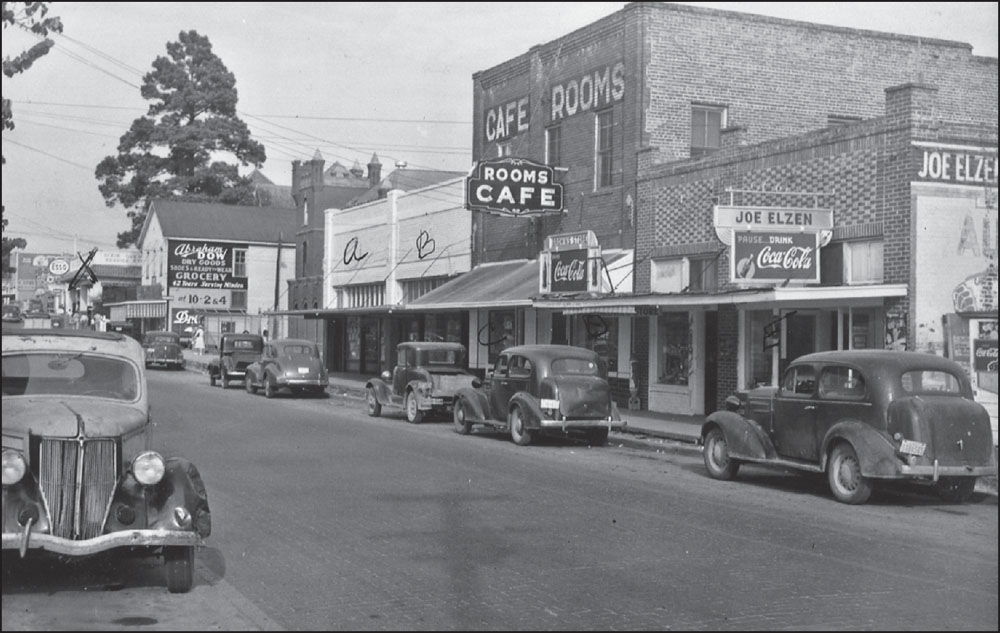
Pictured are some of the local stores on Broadway that were open to both black and white shoppers. Families who had immigrated to the United States and to Minden during the early 20th century, such as the Elzen and Kirkikis families, operated many of these businesses. (Courtesy of the National Archives.)

Here is another view of the Back Street businesses, showing the edge of the lawn of the Webster Parish Courthouse at the left foreground. Just beyond Dow’s Store, one can see the Dixie-Overland Station, named for the Dixie-Overland Highway, today’s US Highway 80. (Courtesy of the National Archives.)

This 1930s image of the Back Street businesses shows the Webster Parish Courthouse after the 1933 tornado, which caused damage and led to the replacement of the original courthouse dome and clock with this larger version with glass windows. (Author’s collection.)

By 1970, the landscape of downtown had changed. The 1905 Webster Parish Courthouse was gone, and the new Minden Civic Center and City Hall Complex had replaced the businesses along Back Street. The old hitching lot had become a modern striped parking lot for cars. (Author’s collection.)

W.S. Hunter founded the local Coca-Cola bottling company in the early 1900s. This is the 1901 location of the company when it was known as the Minden Bottling Company, which was before it housed the region’s Coca-Cola franchise. (Courtesy of LSU-Shreveport Archives and Special Collections, Noel Memorial Library.)

As the Hunters’ business grew, by 1914, the name of the firm had been changed to the North Louisiana Bottling Works, and the company was bottling Coke. At that point, it was located in this building in Minden, which is still the location of the company today. (Courtesy of Ben Hunter.)

By 1926, when this picture was taken, the Minden Coca-Cola Bottling Company was under the control of Larry Hunter, son of founder W.S. Hunter, and had moved into a new building and into the modern era with trucks to distribute its beverages. The contributions of the Hunters to Minden went so far beyond their business that it is difficult to describe. Single-handedly, the family started a recreation program, including summer baseball and swimming for the city. For many years, they allowed the city to use family-owned facilities for $1 per year. The family sponsored the local American Legion baseball team, paying for the squad to travel all across the country to compete, and they also provided the first home for the Minden Redbirds semiprofessional baseball team. Beyond the area of recreation, Larry Hunter’s wife, Gladys Hunter, was the first woman to serve on the Webster Parish School Board. (Courtesy of Ben Hunter.)

The Minden Mill of the Bodcau Lumber Company came to town in 1900 and changed the way of life. Beyond being the town’s major employer, the business also brought electric and natural gas utilities to Minden. At its peak, the mill was among the largest in the world. A fire destroyed the mill in May 1918, and the loss was devastating to the community. The city was left without electricity for months, and only the addition of the L&A Railway a few years later restored economic prosperity. (Above, author’s collection; below, courtesy of David Parker.)


This postcard image of the Minden Lumber Mill gives an idea of the size and complexity of the operation. The mill was easily the largest employer in the town and changed aspects of the landscape of Minden. Several of the millponds remain in place today and are a legacy of the Bodcau Company’s presence. The mill quarters were torn down after the mill closed, and the property was deeded to the city. It was converted into an expansion of the Minden Cemetery, and the lumber company built the streets in use in that part of the cemetery today. Since the mill was involved in producing lumber for the military shipbuilding industry, rumors were spread that the fire that destroyed the mill was sabotage, but no evidence of that claim ever emerged. (Author’s collection.)
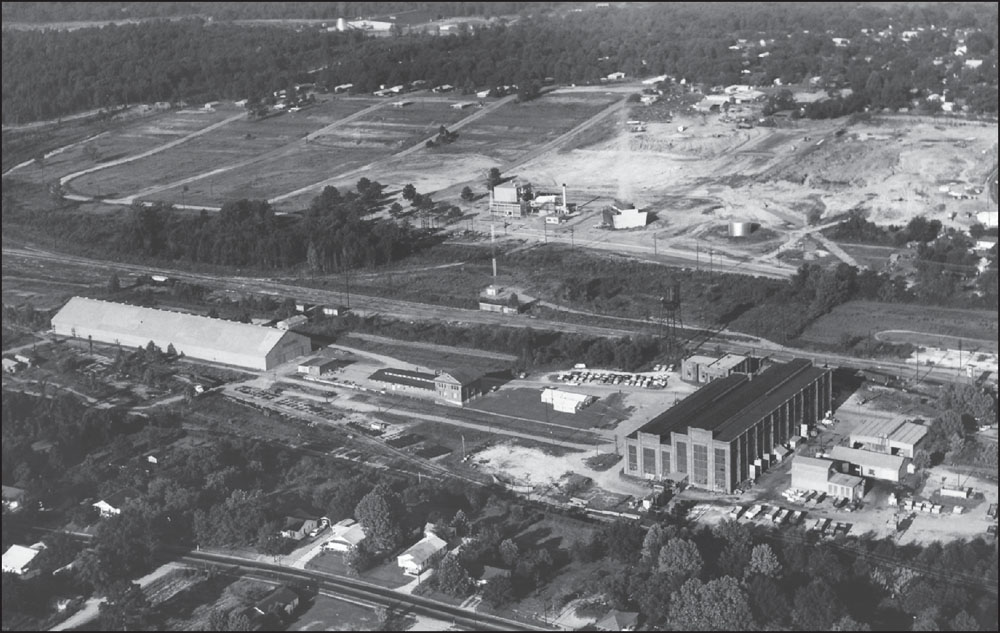
After the loss of the lumber mill, William Buchanan, who owned the Bodcau Company, restored Minden by moving the railroad shops of his Louisiana & Arkansas Railway to Minden in 1923. Those shops are shown in this image. Some years, one in three families in town had a member working for the L&A. (Author’s collection.)

In 1926, the Buchanan family moved the office of the L&A to Minden. This image of the office building was taken after the tornado of May 1, 1933, but the structure was rebuilt and stood in Minden long after the railroad left town in the 1940s. (Author’s collection.)
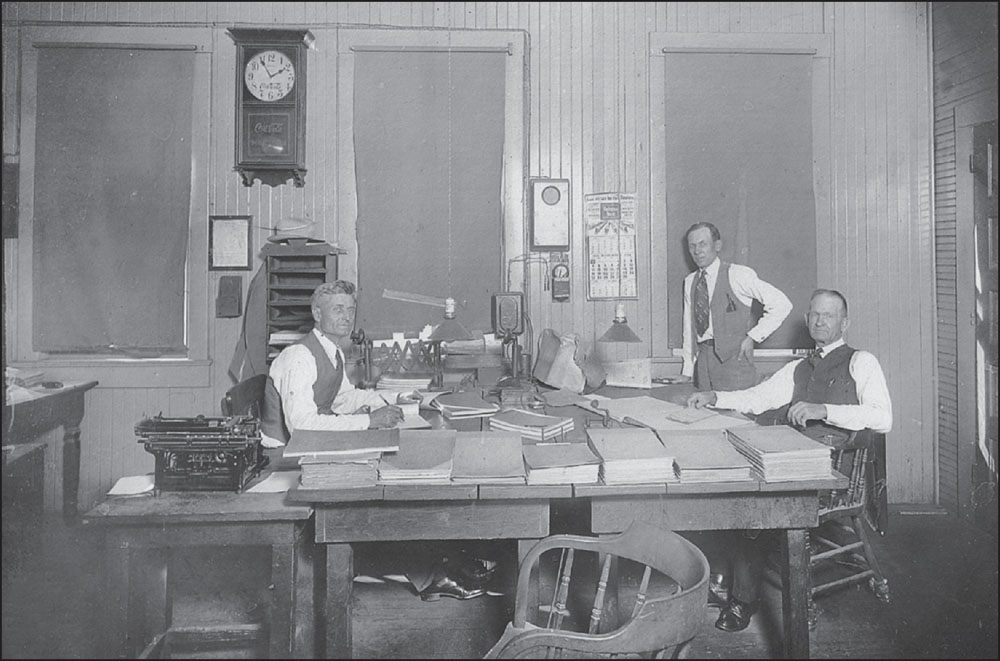
In this image is the freight office of the L&A Railway during the 1920s. The area along the railroad tracks surrounding the depot became home to many businesses and was particularly devastated by the 1933 tornado. (Author’s collection.)

This was the Minden depot of the L&A Railway. This building was used from about 1915 until 1955, when a new, smaller passenger depot was built as the L&A ceased operations in Minden. This depot was torn down after attempts to use it for city purposes failed. (Author’s collection.)

On December 30, 1928, the L&A Railway had the maiden run of its new high-speed train, the Shreveporter. The train arrived at the Minden depot just before midnight and was greeted by this overwhelming crowd, excited by the advent of faster transportation to and from Minden. The number of small children present at such a late hour is surprising. Local rumor has often claimed that this crowd was present to welcome Louisiana’s newly elected governor Huey P. Long, but although Long did deliver more than a dozen speeches in Minden over the years, he was not a passenger on the Shreveporter that night. Minden residents were just enthusiastic at more progress in their town, which many had feared would not grow after the mill fire 10 years earlier. The railroad industry had done much to revive Minden, and the town loved the railroads. (Courtesy of LSU-Shreveport Archives and Special Collections, Noel Memorial Library.)

The arrival of north-south rail transportation directly to Minden in 1900 brought new industries of all kinds to the community. Among the businesses that were established in the commercial area along the railroad tracks was Minden Cotton Oil and Ice, founded by local businessmen just after 1900. The mill produced cottonseed oil and fertilizer and provided ice to local residents for many years. The company’s brand name for their fertilizer was Black Cat, and its building was adorned with the image of a huge black cat. The building remained in place until the mid-1960s, when the land was purchased by the City of Minden. Today, the city has its main warehouse at the location. This is a transitional picture, as the method of delivery of ice and other products to local customers is shifting from wagons to trucks. (Author’s collection.)

On the edges of downtown Minden were other businesses such as Brackin Motors, the local Studebaker dealer. Here, L.H. Brackin is shown on his horse after leading the Webster Parish Fair Parade in about 1947. (Courtesy of the Webster Parish Library.)
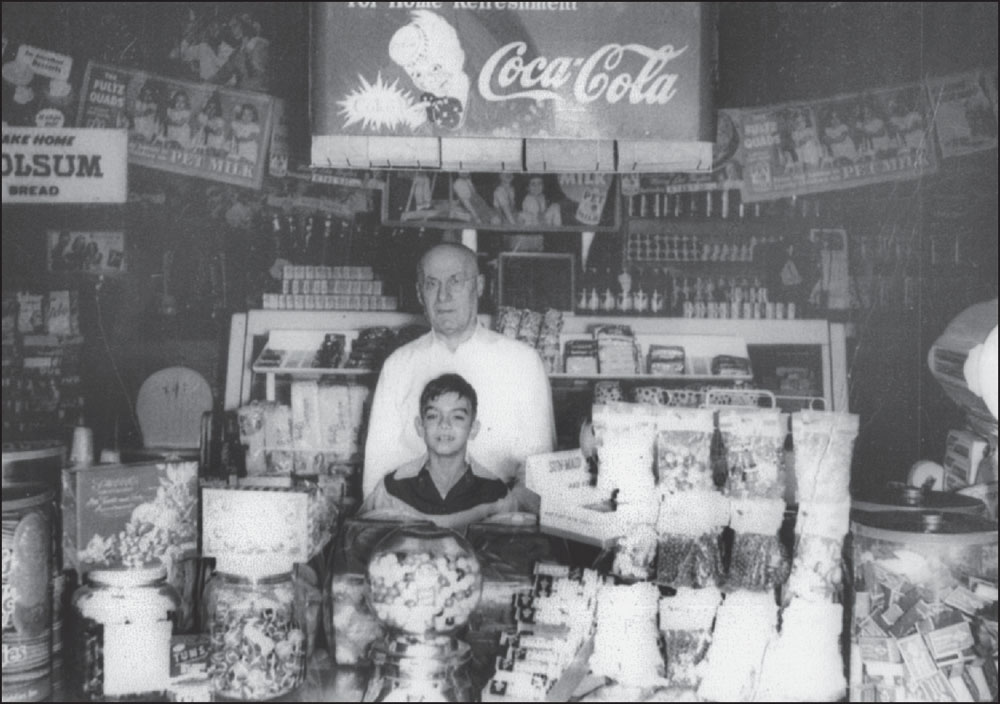
Among the immigrant families coming to Minden from the Middle East was the Mourad family. Here, Isaac Mourad is shown in his store with his younger son, Bobby. The son and grandson of Isaac’s elder son, George, have served Minden as firefighters for decades, and his grandson is currently Minden’s fire chief. (Courtesy of Bobby Mourad.)

From its earliest days, cotton was a vital part of the local economy. This picture shows the wreckage of the Sibley Road Cotton Gin in the wake of the 1933 tornado. The business was rebuilt and continued to operate through the 1940s and into the early 1950s. (Author’s collection.)

Directly across Sibley Road from the gin was the Minden Cotton Compress, where the ginned cotton was packed into tight bales to facilitate shipping. This massive building stood into the 21st century before being torn down in the past few years. (Courtesy of LSU-Shreveport Archives and Special Collections, Noel Memorial Library.)

























































